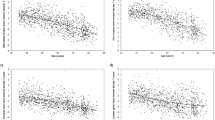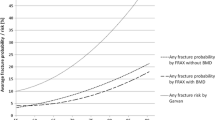Abstract
Summary
We assessed the association between the rate of forearm bone loss and non-vertebral fracture. Bone loss at the distal forearm predicted fractures, independently of baseline BMD, but not independently of follow-up BMD in women. The BMD level where an individual ends up is the significant predictor of fracture risk.
Introduction
Bone loss may predict fracture risk independently of baseline BMD. The influence of follow-up BMD on this prediction is unknown. The aim of this study was to assess the association between bone loss and fracture risk in both sexes in a prospective population-based study.
Methods
We included 1,208 postmenopausal women (50 to 74 years), and 1,336 men (55 to 74 years) from the Tromsø Study, who had repeated distal and ultra-distal forearm BMD measurements. Non-vertebral fractures were registered from 2001 to 2005.
Results
A total of 100 women and 46 men sustained fractures during the follow-up time. Independent of baseline BMD, the RR associated with distal site bone loss of 1 SD %/year was 1.23 (1.01-1.50) for low-trauma fractures (excluding hand, foot, skull & high-trauma) and 1.32 (1.07-1.62) for osteoporotic fractures (hip, wrist and shoulder). However, bone loss did not predict fracture after adjusting for follow-up BMD. The BMD level where an individual ends up became the significant predictor of fracture risk and not the rate of bone loss. Follow-up BMD at ultra-distal site was associated with low-trauma fractures in both sexes. While ultra-distal site BMD changes were not associated with fracture risk in both sexes.
Conclusion
Bone loss at the distal forearm predicted non-vertebral fractures, independently of baseline BMD, but not independently of follow-up BMD, in women. The BMD level where an individual ends up is the significant predictor of fracture risk and not the rate of bone loss.



Similar content being viewed by others
Abbreviations
- BMD:
-
Bone mineral density
- RR:
-
Relative risk
- SD:
-
Standard deviation
References
Cummings SR, Melton LJ (2002) Epidemiology and outcomes of osteoporotic fractures. Lancet 359:1761–1767 [see comment]
Melton LJ 3rd (2003) Adverse outcomes of osteoporotic fractures in the general population. J Bone Miner Res 18:1139–1141
NIH Consensus Panel (1993) Consensus development conference: diagnosis, prophylaxis, and treatment of osteoporosis. Am J Med 94:646–650
Kanis JA (2002) Diagnosis of osteoporosis and assessment of fracture risk. Lancet 359:1929–1936
Bass S, Delmas PD, Pearce G, Hendrich E, Tabensky A, Seeman E (1999) The differing tempo of growth in bone size, mass, and density in girls is region-specific. J Clin Invest 104:795–804 [see comment]
Hough S (1998) Fast and slow bone losers. Relevance to the management of osteoporosis. Drugs & Aging 12(Suppl 1):1–7
Kanis JA, Borgstrom F, De Laet C, Johansson H, Johnell O, Jonsson B, Oden A, Zethraeus N, Pfleger B, Khaltaev N (2005) Assessment of fracture risk. Osteoporos Int 16:581–589
Garnero P, Sornay-Rendu E, Chapuy MC, Delmas PD (1996) Increased bone turnover in late postmenopausal women is a major determinant of osteoporosis. J Bone Miner Res 11:337–349
Garnero P, Hausherr E, Chapuy MC, Marcelli C, Grandjean H, Muller C, Cormier C, Breart G, Meunier PJ, Delmas PD (1996) Markers of bone resorption predict hip fracture in elderly women: the EPIDOS Prospective Study. J Bone Miner Res 11:1531–1538
Garnero P, Dargent MP, Hans D, Schott AM, Breart G, Meunier PJ, Delmas PD (1998) Do markers of bone resorption add to bone mineral density and ultrasonographic heel measurement for the prediction of hip fracture in elderly women? The EPIDOS Prospective Study. Osteoporos Int 8:563–569
Garnero P, Sornay-Rendu E, Claustrat B, Delmas PD (2000) Biochemical markers of bone turnover, endogenous hormones and the risk of fractures in postmenopausal women: the OFELY study. J Bone Miner Res 15:1526–1536
Johnell O, Oden A, De Laet C, Garnero P, Delmas PD, Kanis JA (2002) Biochemical indices of bone turnover and the assessment of fracture probability. Osteoporos Int 13:523–526
Vergnaud P, Garnero P, Meunier PJ, Breart G, Kamihagi K, Delmas PD (1997) Undercarboxylated osteocalcin measured with a specific immunoassay predicts hip fracture in elderly women: the EPIDOS study. JClin EndocrinolMetab 82:719–724
Riis BJ, Hansen MA, Jensen AM, Overgaard K, Christiansen C (1996) Low bone mass and fast rate of bone loss at menopause: equal risk factors for future fracture: a 15-year follow- up study. Bone 19:9–12
Gnudi S, Malavolta N, Lisi L, Ripamonti C (2001) Bone mineral density and bone loss measured at the radius to predict the risk of nonspinal osteoporotic fracture. J Bone Miner Res 16:1130–1135
Nguyen TV, Center JR, Eisman JA (2005) Femoral neck bone loss predicts fracture risk independent of baseline BMD. J Bone Miner Res 20:1195–1201
Sornay-Rendu E, Munoz F, Duboeuf F, Delmas PD (2005) Rate of forearm bone loss is associated with an increased risk of fracture independently of bone mass in postmenopausal women: the OFELY study. J Bone Miner Res 20:1929–1935
Hillier TA, Stone KL, Bauer DC, Rizzo JH, Pedula KL, Cauley JA, Ensrud KE, Hochberg MC, Cummings SR (2007) Evaluating the value of repeat bone mineral density measurement and prediction of fractures in older women: the study of osteoporotic fractures. Arch Intern Med 167:155–160
Berger C, Langsetmo L, Joseph L, Hanley DA, Davison KS, Josse RG, Prior JC, Kreiger N, Tenenhouse A, Goltzman D (2009) Association between change in BMD and fragility fracture in women and men. J Bone Miner Res 24:361
Berntsen GK, Fonnebo V, Tollan A, Sogaard AJ, Magnus JH (2001) Forearm bone mineral density by age in 7,620 men and women: the Tromso study, a population-based study. Am J Epidemiol 153:465–473
Schlenker RA, VonSeggen WW (1976) The distribution of cortical and trabecular bone mass along the lengths of the radius and ulna and the implications for in vivo bone mass measurements. Calcif Tissue Res 20:41–52
Berntsen GK, Tollan A, Magnus JH, Sogaard AJ, Ringberg T, Fonnebo V (1999) The Tromsø Study: artifacts in forearm bone densitometry—prevalence and effects. Osteoporos Int 10:425–432
Berntsen GK, Fonnebo V, Tollan A, Sogaard AJ, Joakimsen RM, Magnus JH (2000) The Tromsø Study: determinants of precision in bone densitometry. J Clin Epidemiol 53:1104–1112
Emaus N, Berntsen GK, Joakimsen R, Fonnebo V (2005) Bone mineral density measures in longitudinal studies: the choice of phantom is crucial for quality assessment. The Tromso study, a population-based study. Osteoporos Int 16:1597–1603
Joakimsen RM, Fonnebo V, Sogaard AJ, Tollan A, Stormer J, Magnus JH (2001) The Tromso study: registration of fractures, how good are self-reports, a computerized radiographic register and a discharge register? Osteoporos Int 12:1001–1005
Emaus N, Berntsen GK, Joakimsen R, Fonnebo V (2006) Longitudinal changes in forearm bone mineral density in women and men aged 45–84 years: the Tromso Study, a population-based study. Am J Epidemiol 163:441–449
Ensrud KE, Palermo L, Black DM, Cauley J, Jergas M, Orwoll ES, Nevitt MC, Fox KM, Cummings SR (1995) Hip and calcaneal bone loss increase with advancing age: longitudinal results from the study of osteoporotic fractures. J Bone Miner Res 10:1778–1787
Nguyen TV, Sambrook PN, Eisman JA (1998) Bone loss, physical activity, and weight change in elderly women: the Dubbo Osteoporosis Epidemiology Study. J Bone Miner Res 13:1458–1467
Riis BJ (1995) The role of bone loss. Am J Med 98:S29–S32
Sowers M, Clark K, Wallace R, Jannausch M, Lemke J (1991) Prospective study of radial bone mineral density in a geographically defined population of postmenopausal Caucasian women. Calcif Tissue Int 48:232–239
Cauley JA, Lui L-Y, Barnes D, Ensrud KE, Zmuda JM, Hillier TA, Hochberg MC, Schwartz AV, Yaffe K, Cummings SR, Newman AB (2009) Successful skeletal aging: a marker of low fracture risk and longevity. The study of osteoporotic fractures (SOF). J Bone Miner Res 24:134–143
Bainbridge KE, Sowers MF, Crutchfield M, Lin X, Jannausch M, Harlow SD (2002) Natural history of bone loss over 6 years among premenopausal and early postmenopausal women. Am J Epidemiol 156:410–417
Burger H, de-Laet CE, van-Daele PL, Weel AE, Witteman JC, Hofman A, Pols HA (1998) Risk factors for increased bone loss in an elderly population: the Rotterdam Study. Am J Epidemiol 147:871–879
Hannan MT, Felson DT, Dawson-Hughes B, Tucker KL, Cupples LA, Wilson PW, Kiel DP (2000) Risk factors for longitudinal bone loss in elderly men and women: the Framingham Osteoporosis Study. J Bone Miner Res 15:710–720
Hui SL, Slemenda CW, Johnston CC Jr (1990) The contribution of bone loss to postmenopausal osteoporosis. Osteoporos Int 1:30–34
Jones G, Nguyen T, Sambrook P, Kelly PJ, Eisman JA (1994) Progressive loss of bone in the femoral neck in elderly people: longitudinal findings from the Dubbo osteoporosis epidemiology study. BMJ 309:691–695
Melton LJ, Atkinson EJ, O'Connor MK, O'Fallon WM, Riggs BL (2000) Determinants of bone loss from the femoral neck in women of different ages. J Bone Miner Res 15:24–31
Kanis JA, Johnell O, Oden A, De Laet C, Mellstrom D (2004) Epidemiology of osteoporosis and fracture in men. Calcif Tissue Int 75:90–99
Melton LJ 3rd, Orwoll ES, Wasnich RD (2001) Does bone density predict fractures comparably in men and women? Osteoporos Int 12:707–709
Orwoll E (2000) Assessing bone density in men. J Bone Miner Res 15:1867–1870
Seeman E (2003) The structural and biomechanical basis of the gain and loss of bone strength in women and men. Endocrinol Metab Clin North Am 32:25–38
Seeman E (2008) Bone quality: the material and structural basis of bone strength. J Bone Miner Metab 26:1–8
Marshall D, Johnell O, Wedel H (1996) Meta-analysis of how well measures of bone mineral density predict occurrence of osteoporotic fractures. BMJ 312:1254–1259
Stone KL, Seeley DG, Lui LY, Cauley JA, Ensrud K, Browner WS, Nevitt MC, Cummings SR, Osteoporotic Fractures Research Group (2003) BMD at multiple sites and risk of fracture of multiple types: long-term results from the study of osteoporotic fractures. J Bone Miner Res 18:1947–1954
Acknowledgment
This work was supported by grant from the Centre for Research in the Elderly in Tromsø, the Northern Norway Regional Health Authority.
Conflicts of interest
None.
Author information
Authors and Affiliations
Corresponding author
Electronic supplementary material
Below is the link to the electronic supplementary material.
ESM 1
(PDF 46 kb)
Rights and permissions
About this article
Cite this article
Ahmed, L.A., Emaus, N., Berntsen, G.K. et al. Bone loss and the risk of non-vertebral fractures in women and men: the Tromsø study. Osteoporos Int 21, 1503–1511 (2010). https://doi.org/10.1007/s00198-009-1102-z
Received:
Accepted:
Published:
Issue Date:
DOI: https://doi.org/10.1007/s00198-009-1102-z




